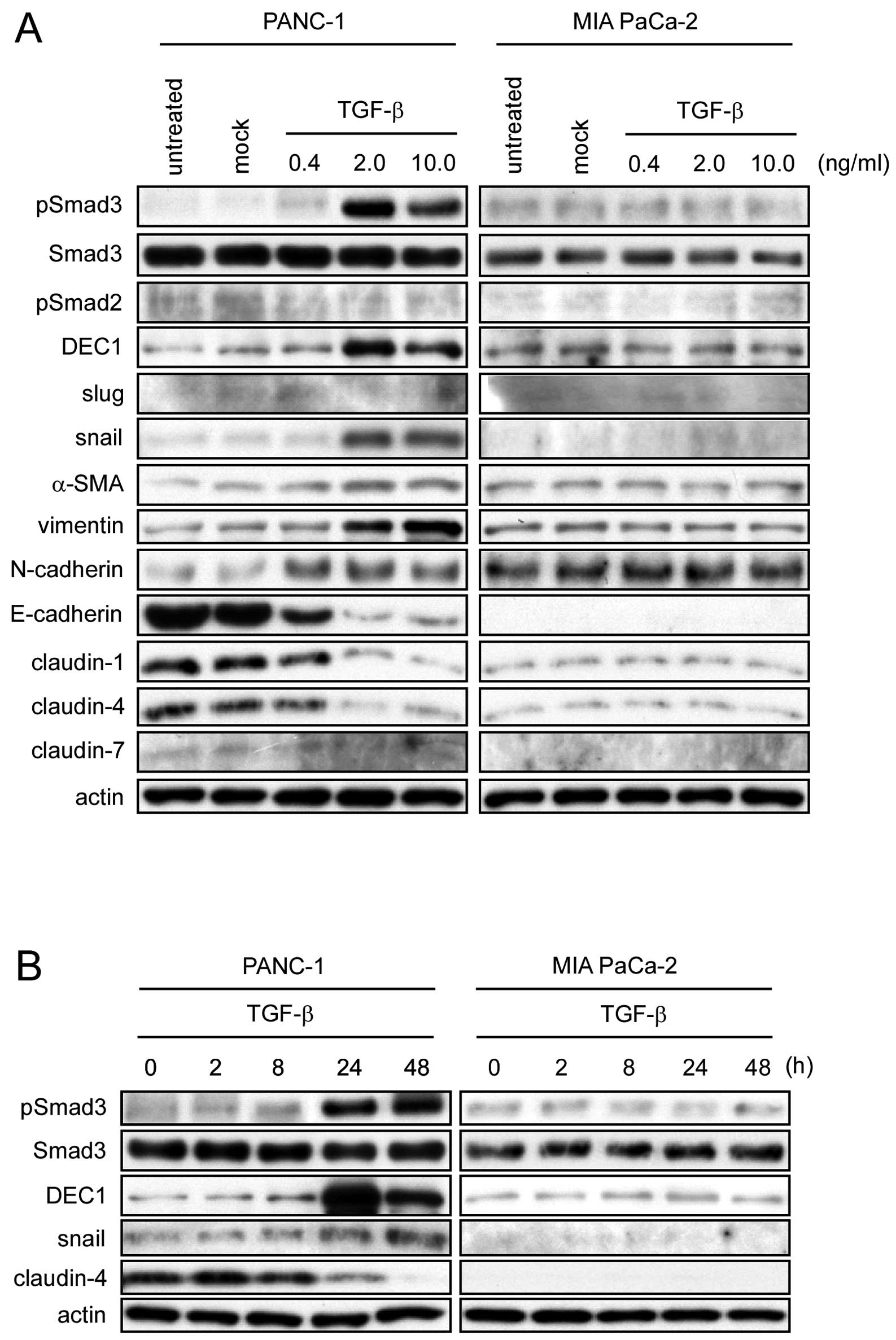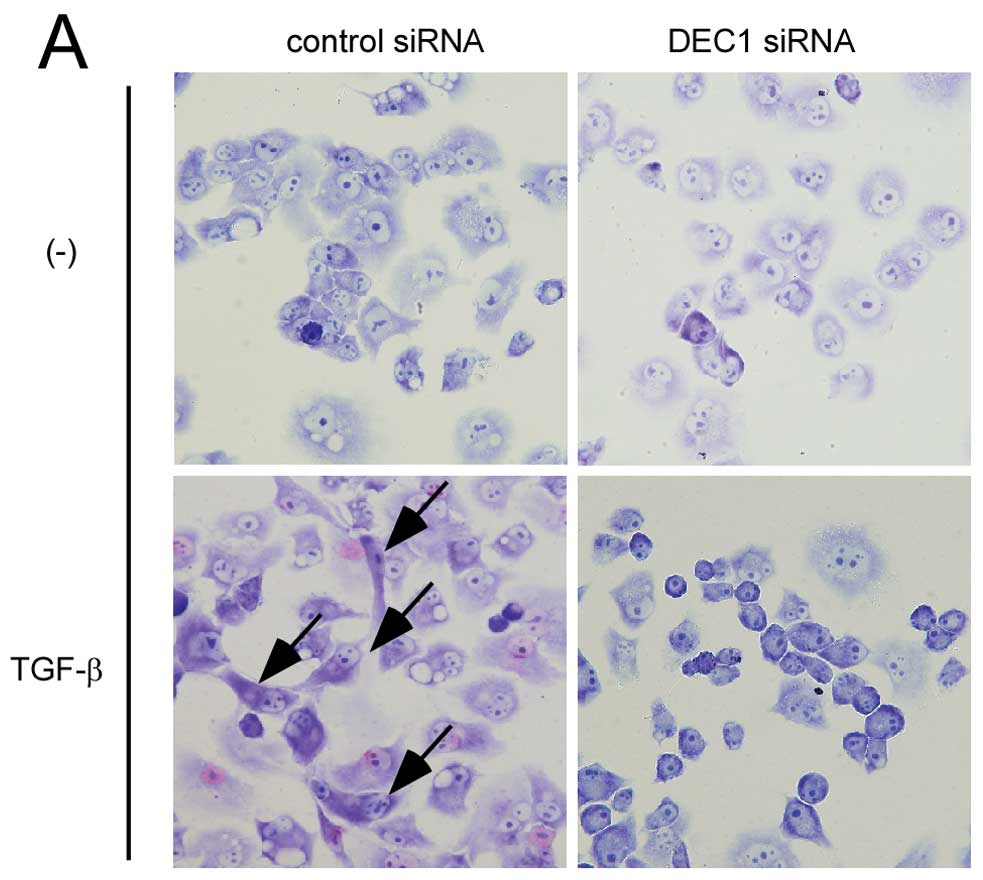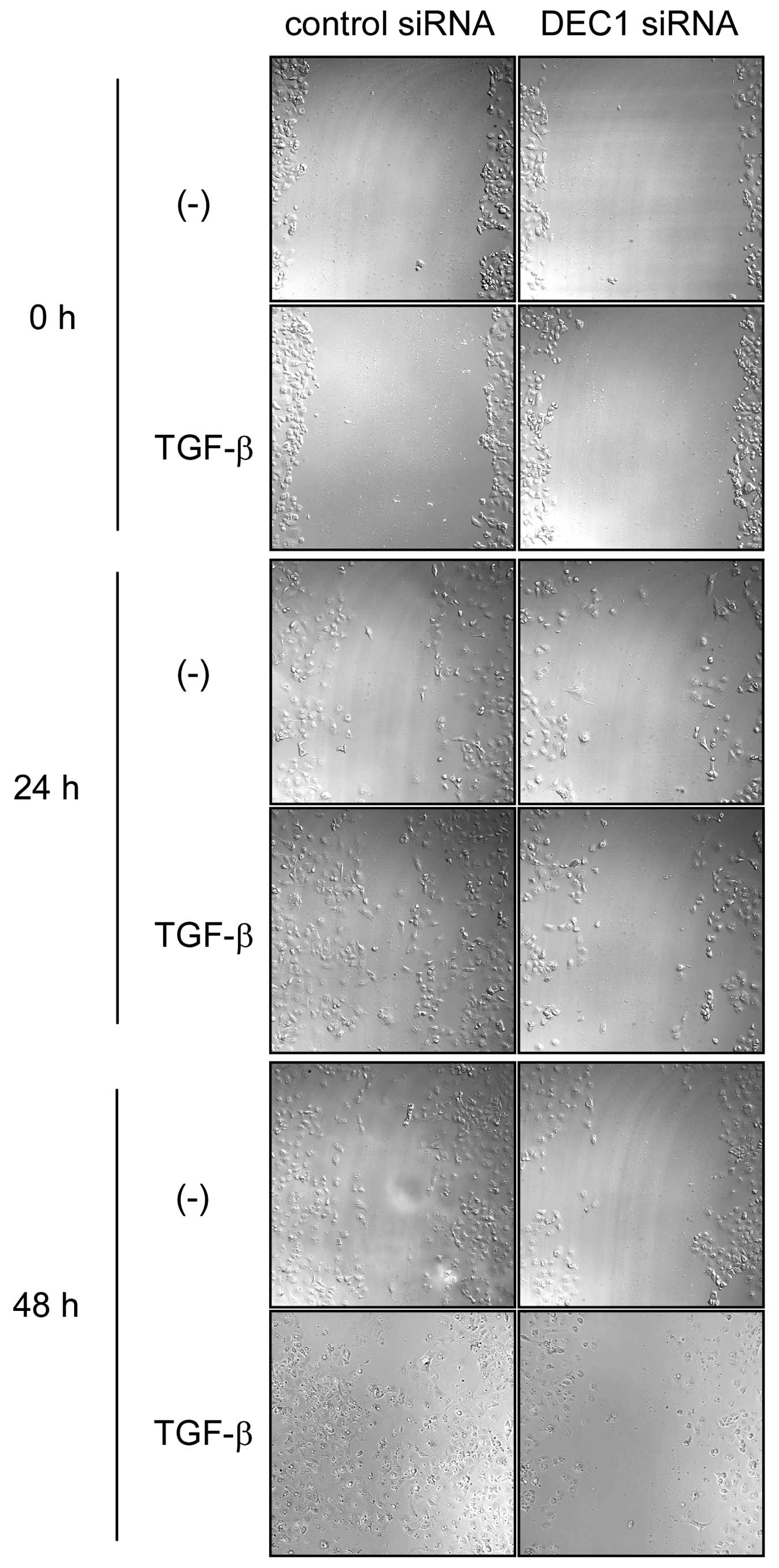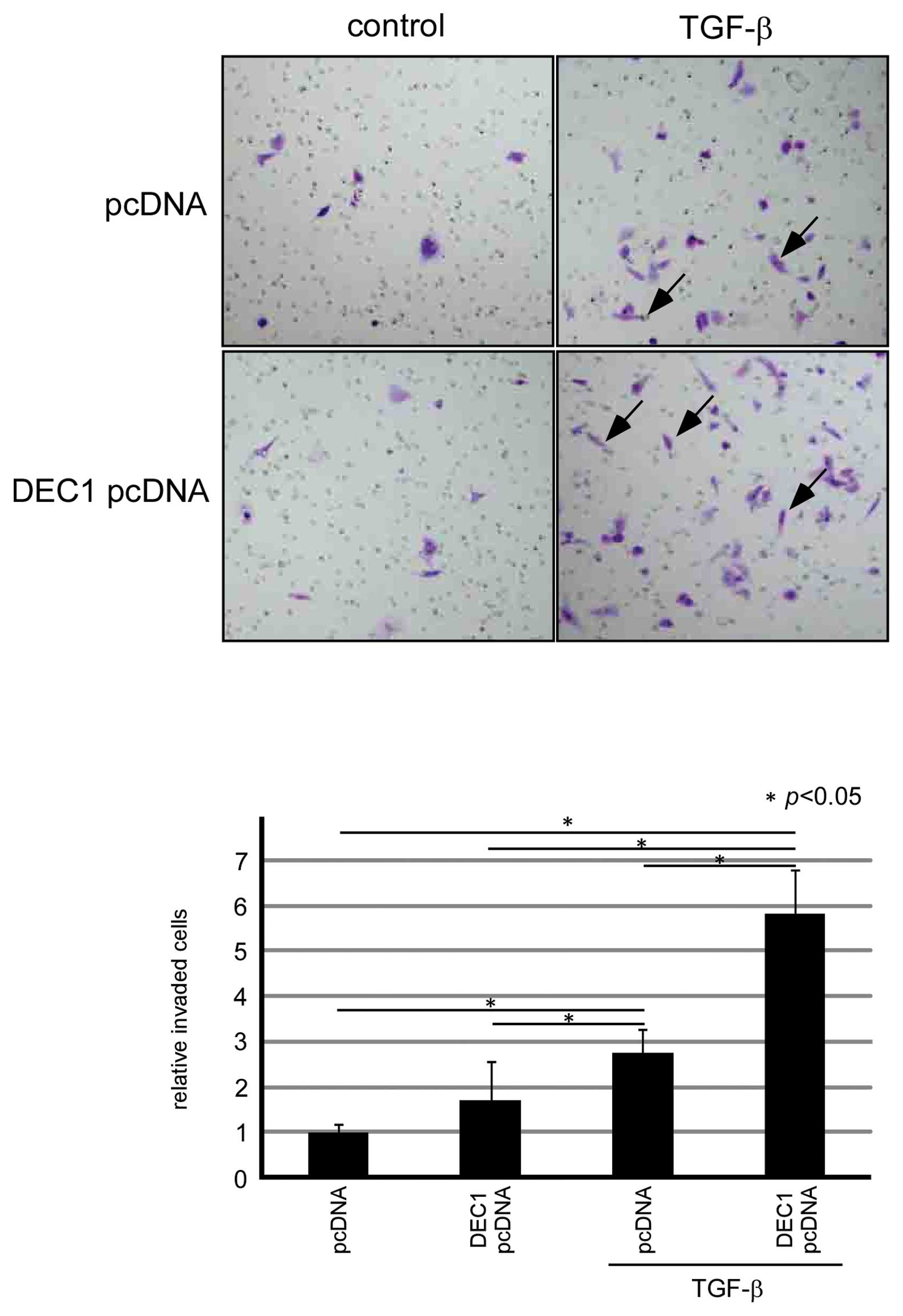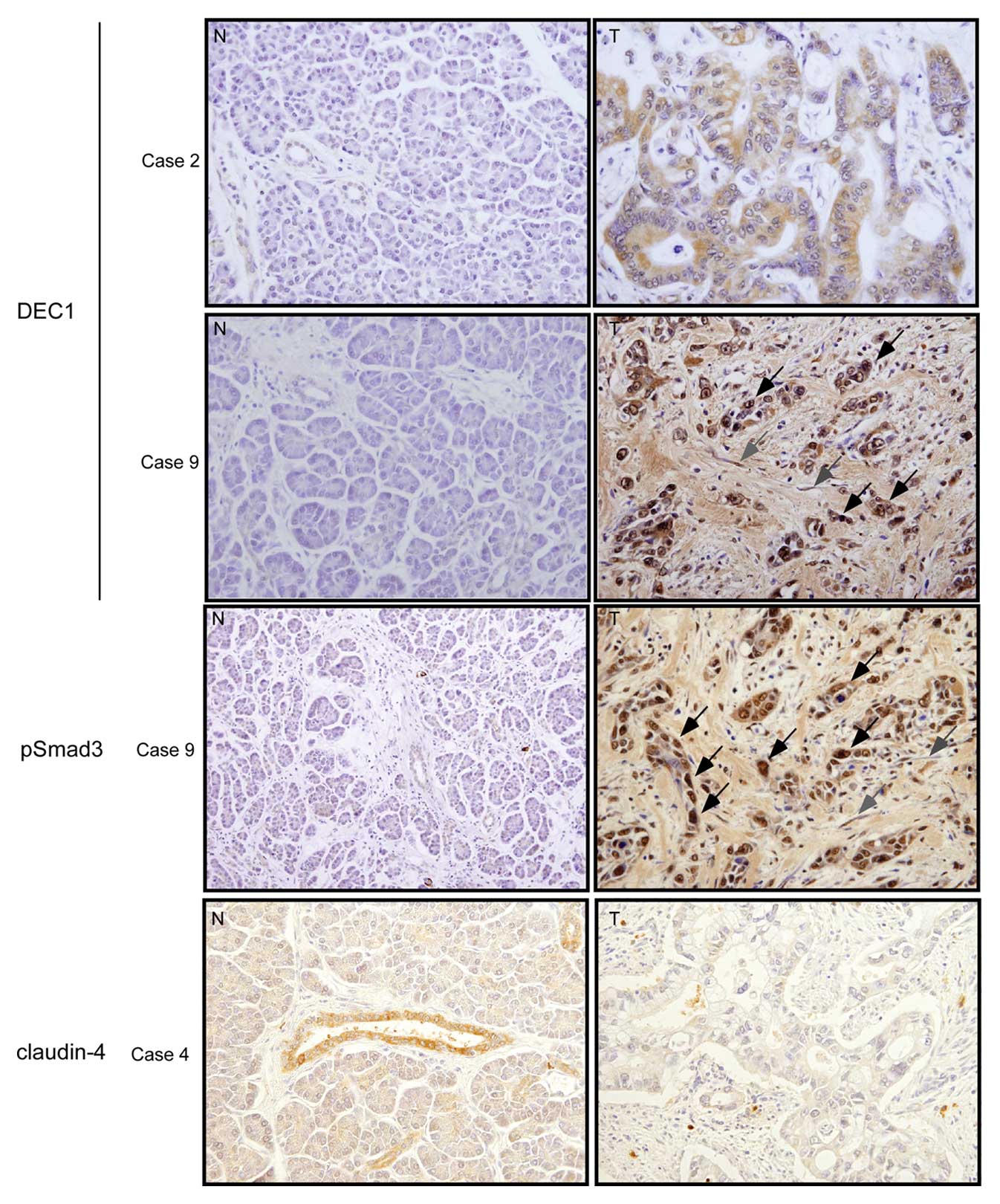The BHLH transcription factor DEC1 plays an important role in the epithelial-mesenchymal transition of pancreatic cancer
- Authors:
- Published online on: July 18, 2012 https://doi.org/10.3892/ijo.2012.1559
- Pages: 1337-1346
Abstract
Introduction
Epithelial-mesenchymal transition (EMT) is a dynamic process that occurs during the tumor progression of various cancers. It is characterized by the loss of epithelial factors, including E-cadherin, claudins, and cytokeratins, and the upregulated expression of mesenchymal markers, including N-cadherin, vimentin and fibronectin. Cancer cells that have undergone EMT are thought to acquire a fibroblast-like motile and an invasive phenotype (1,2).
Transforming growth factor (TGF)-β one of the most potent inducers of EMT, induces spindle-shaped cell morphology, inhibits cell proliferation, and promotes tumor cell motility and invasion (2–4). TGF-β binds to two different serine/threonine kinase receptors; type I (TGF-βRI) and type II receptors (TGF-βRII). The formation of hetero-dimers of TGF-βRI and TGF-βRII leads to the activation of the signaling pathways mediated by TGF-β (5). Human pancreatic cancer (PANC-1) cells express both TGF-βRI and TGF-βRII, whereas MIA PaCa-2 pancreatic cancer cells do not express either of them (6). Smads are key intracellular mediators of the transcriptional responses to TGF-β, and Smad4 mutations are known to be present in more than 50% of pancreatic cancer cases (7,8). In addition, the activation of other Smads plays important roles in the tumor progression of pancreatic cancer. The phosphorylation of Smad2 and Smad3 causes them to translocate from the cytoplasm to the nucleus and associate with Smad4. In the nucleus, the activated Smad complex binds to target gene promoters and regulates the transcriptional responses to TGF-β (5,9,10).
There are several EMT inducing transcription factors, such as snail, slug, twist and ZEB1 (11–14). Since there were some reports on the roles of snail in PANC-1, we selected snail as a marker of positive control during EMT. Snail is expressed in various tumor cells and regulates the expression of E-cadherin, claudins, and some mesenchymal markers, which are involved in tumor invasion, metastasis, and cell motility (1,15,16). Furthermore, TGF-β directly activates snail transcription through the Smad3 phosphorylation (17).
We have shown that DEC1 (BHLHE40/Stra13/Sharp2) is involved in the regulation of apoptosis and the cell cycle in human breast and oral cancer cells (18–20). DEC1 is also highly expressed in various tumors (20–24). However, the role of DEC1 in EMT is still unknown. In this study, we focused on the role of DEC1 in EMT of pancreatic cancer cells during TGF-β treatment and demonstrated that DEC1 plays important roles in EMT of pancreatic cancer cells.
Materials and methods
Cell culture and treatment
Human pancreatic cancer PANC-1 and MIA PaCa-2 cells were cultured as described previously (25,26). These cells were incubated with recombinant human TGF-β (R&D Systems, Minneapolis, MN, USA) or A-83-01 (Takara, Shiga, Japan) at various concentrations and periods.
Knockdown of DEC1 by RNA interference
Short interference RNA (siRNA) against DEC1 was synthesized by Qiagen (Hilden, Germany). The sequences of the sense and anti-sense DEC1 siRNA and the negative control (scrambled) siRNA, and the siRNA transfection were performed as described previously (18).
DEC1 overexpression
DEC1 overexpression was induced using pcDNA vector as described previously (19). After transfection, the cells were incubated for 24 h and subjected to the invasion assay.
Western blotting
Cells were lysed using M-PER lysis buffer (Thermo Scientific, Rockford, IL, USA) and their protein concentration was determined using the bicinchoninic acid (BCA) assay. Their lysates were subjected to SDS-PAGE and detected the protein expression as described previously (18,19).
Antibodies
The membranes for western blotting were incubated with antibodies specific to DEC1 (1:10,000; Novus Biologicals Inc., Littleton, CO, USA), Smad3 (1:1,000; Epitomics Inc., Burlingame, CA, USA), pSmad3 (1:6,000; Epitomics), phospho extracellular signal-related kinases (p-ERK)½ (1:1,000; Epitomics), pSmad2 (1:5,000; Invitrogen, Carlsbad, CA, USA), slug (1:3,000; Cell Signaling Technology Inc.), snail (1:3,000; Cell Signaling Technology Inc., Danvers, MA, USA), ERK1/2 (1:30,000; Cell Signaling Technology Inc.), α-smooth muscle actin (α-SMA) (1:20,000; Sigma Chemical Co., St. Louis, MO, USA), vimentin (1:10,000; Epitomics), N-cadherin (1:10,000; ECM Biosciences, Versailles, KY, USA), E-cadherin (1:1000; Takara), claudin-1 (1:10,000; Invitrogen), claudin-4 (1:20,000; Invitrogen), claudin-7 (1:1,000; Invitrogen), and actin (1:30,000; Sigma), followed by horseradish peroxidase-conjugated secondary antibody (Immuno-Biological Laboratories, Fujioka, Japan). Can Get Signal immunoreaction enhancer solution (Toyobo Co. Ltd., Osaka, Japan) or Immunoshot immunoreaction enhancer solution (Cosmobio Co. Ltd., Tokyo, Japan) was used to dilute the primary antibody.
Real-time polymerase chain reaction (PCR)
We prepared three independent RNA samples (n=3). Total-RNA was isolated and first-strand cDNA was synthesized as described previously (19). The real-time PCR was performed using SYBR-Green Master Mix (Life Technologies, Carlsbad, CA, USA). The sequences of the primers and the sizes of products are shown in Table I.
Immunofluorescent staining
Immunofluorescent staining was performed as described previously (18). The permeabilized cells were incubated with anti-DEC1 (1:300), pSmad3 (1:300), snail (1:300), N-cadherin (1:300), E-cadherin (1:300), claudin-1 (1:300), claudin-4 (1:300), or claudin-7 (1:300) antibodies at 4°C overnight. The cells were then incubated for 1 h with goat anti-rabbit IgG antibody conjugated to Alexa 488 dye (Molecular Probes Inc., Tokyo, Japan), while nuclear staining was performed using 4′,6-diamidino-2-phenylindole (DAPI). These cells were visualized using confocal laser scanning microscopy LSM 710 (Zeiss, Wetzlar, Germany).
Cell stain was carried out using the CnT-ST-100 stain kit (CellnTEC Advanced Cell Systems AG, Bern, Switzerland), in accordance with the manufacturer’s instructions.
Invasion assay and migration assay
The invasion assay was performed using a BD BioCoat Matrigel invasion chamber kit (Becton Dickinson, Franklin Lakes, NJ, USA). PANC-1 cells were separated using cell dissociation solution (Sigma) and then (5×104 cells/600 μl) were added to the top chamber of a cell culture insert in a 24-well companion plate. After overnight incubation, the cells that had invaded the lower surface of the membrane were fixed with methanol and subjected to Giemsa staining. The number of cells that had migrated was quantified by counting them in ten random distinct fields using a light microscope.
For the migration assay, PANC-1 cells were seeded in a 4-chamber slide glass, and an artificial ‘wound’ was carefully created at 0 h by scratching the confluent cell monolayer with the tip of a P-200 pipette. Microphotographs were taken at 0, 24 and 48 h.
Human pancreatic tissues
We examined immunohistochemical analyses of surgically resected pancreatic cancers (n=17), which have been filed in Hirosaki University Hospital, Japan (Table II). All of the 17 cases examined were invasive ductal carcinoma of pancreas. Histological specimens were retrieved from the archives of our hospital according to the guidelines produced by the Japanese Society of Pathology.
Table IIImmunohistochemical expression of DEC1, pSmad3, and claudin-4 proteins in human pancreatic cancer tissues. |
Immunohistochemistry
Immunohistochemistry was performed as described previously (27). The sections were incubated overnight at 4°C with anti-DEC1 (1:100), pSmad3 (1:200), or claudin-4 (1:400) antibodies diluted in Can Get Signal Immunostain Solution (Toyobo Co.). Finally, the sections were counterstained with Mayer’s hematoxylin.
Results
DEC1 expression was induced by TGF-β in PANC-1 cells
TGF-β treatment induced Smad3 phosphorylation, and upregulated the expression of DEC1, snail, α-SMA, vimentin and N-cadherin, whereas it downregulated E-cadherin, claudin-1 and claudin-4 in PANC-1 cells (Fig. 1A and B). The highest level of DEC1 expression was observed in the cells treated with 2 ng/ml of TGF-β for 24 h. TGF-β had little effect on the Smad2 phosphorylation and the expression of Smad3, slug and claudin-7 in PANC-1 cells. On the other hand, no apparent effects were observed on the expression of the aforementioned molecules after TGF-β treatment in MIA PaCa-2 cells. Next, we investigated the endogenous mRNA expression of these proteins in PANC-1 cells treated with TGF-β. The expression of DEC1, snail and N-cadherin was upregulated by TGF-β, whereas the expression of E-cadherin and claudin-4 was downregulated (Fig. 1C). A-83-01-an inhibitor of the TGF-β signaling pathway prevents Smad2/3 phosphorylation. We therefore investigated whether A-83-01 affects the Smad3 phosphorylation and DEC1 expression induced by TGF-β in PANC-1 cells. A-83-01 suppressed the Smad3 phosphorylation, and the expression of DEC1 and snail. On the other hand, claudin-4 expression was upregulated by A-83-01 (Fig. 1D).
DEC1 knockdown suppressed EMT induced by TGF-β
The cells that were transfected with the control siRNA showed a spindle-shaped morphology after 24 h treatment with TGF-β, while the cells transfected with DEC1 siRNA displayed no morphological changes after the same treatment (Fig. 2A). As shown in Fig. 2B, in the absence of TGF-β, DEC1 siRNA upregulated the expression of claudin-4, claudin-7 and E-cadherin, and downregulated the expression of N-cadherin, whereas it had little effect on the Smad3 phosphorylation, and the expression of snail and claudin-1. In the presence of TGF-β, DEC1 siRNA decreased the Smad3 phosphorylation, and the expression of snail and N-cadherin, whereas it upregulated the expression of claudin-1, claudin-4, claudin-7, and E-cadherin. In the presence or absence of TGF-β, DEC1 siRNA had little effect on the ERK1/2 phosphorylation, and the expression of total-ERK1/2, α-SMA and vimentin. Another DEC1 siRNA oligonucleotide yielded similar results (data not shown). In order to examine whether DEC1 regulates EMT-related factors at the transcriptional level, we performed real-time PCR analysis. The altered mRNA expression patterns of snail, E-cadherin, claudin-4 and N-cadherin were compatible with the above protein results (Fig. 2C). In the presence of TGF-β, DEC1 siRNA also significantly decreased the expression of TGF-βRI, although DEC1 siRNA without TGF-β slightly decreased the expression of TGF-βRI. DEC1 siRNA regardless of TGF-β had little effect on the expression of TGF-βRII (data not shown).
Effects of DEC1 knockdown on the amounts of nuclear/cytoplasmic EMT-related factors
As shown in Fig. 2D, DEC1 siRNA without TGF-β decreased the amount of N-cadherin in the cell membrane, while it increased the cell membrane levels of E-cadherin, claudin-4 and claudin-7. On the other hand, DEC1 siRNA without TGF-β had little effect on the amounts of nuclear/cytoplasmic pSmad3, snail and claudin-1. In the presence of TGF-β, control siRNA increased the levels of pSmad3 and snail in the nucleus compared with the absence of TGF-β, and slightly increased the level of N-cadherin in the cell membrane, whereas it decreased the amounts of E-cadherin and claudin-1 in the cell membrane, and decreased the amount of claudin-4 in the cytoplasm. However, it had little effect on the amount of claudin-7 in the cytoplasm or membrane. In the presence of TGF-β, DEC1 siRNA decreased the levels of pSmad3 and snail in the nucleus compared with control siRNA, and it also decreased the amount of N-cadherin in the cell membrane. On the other hand, a combination treatment of DEC1 siRNA with TGF-β significantly increased the levels of E-cadherin, claudin-1 and claudin-4 in the cell membrane compared with control siRNA. A combination treatment of DEC1 siRNA with TGF-β also slightly increased the amount of claudin-7 in the cell membrane. These findings demonstrated that DEC1 has inducible effects on EMT in PANC-1 cells during TGF-β treatment, which involved alterations in the cellular amounts of EMT-related factors.
In the presence of TGF-β, DEC1 expression was closely involved in the migration and invasion
We examined whether DEC1 expression was involved in the migration and invasion of PANC-1 cells. In the presence of TGF-β, DEC1 siRNA delayed cell migration for 24–48 h in comparison with those transfected with the control siRNA (Fig. 3). We performed an invasion assay in which we transiently transfected the cells with a DEC1 expressing plasmid. As a result, the number of invasive PANC-1 cells with a spindle-shaped morphology was increased in the presence of TGF-β (Fig. 4). The invasion assay also demonstrated that there were significantly more invasive spindle-shaped cells among the cells transfected with DEC1 than among those transfected with the control pcDNA vector.
DEC1, pSmad3 and claudin-4 protein expression in human pancreatic cancer tissues and the adjacent non-cancerous pancreatic tissues
We examined the immunohistochemical expression of DEC1, pSmad3 and claudin-4 in human pancreatic cancer tissues. Photographs of DEC1, pSmad3 and claudin-4 expression in representative cases are shown in Fig. 5. Significant DEC1 immunoreactivity was detected in the cancer tissues (100%, 17/17 cases) compared with the adjacent non-cancerous pancreatic tissues, and it was predominantly located within the cytoplasm of the cancer cells, although very weak DEC1 immunoreactivity was found in the non-cancerous pancreatic ductal cells of all cases. DEC1 immunoreactivity was detected in parts of the adjacent non-cancerous tissues (17%, 3/17 cases).
It is often difficult to distinguish between spindle-shaped cells of the cancer invasive front and fibroblasts in stroma. We distinguish them by dyskaryosis and size. Firstly, dyskaryosis was shown in spindle-shaped cells, whereas it was not shown in fibroblasts in stroma. Secondary, the sizes of spindle-shaped cells were larger than fibroblasts. The spindle-shaped cells of the cancer invasive front showed strong DEC1 immunoreactivity similar to that seen in the other cancer regions (case 9, right panel). Marked claudin-4 immunoreactivity was detected in the membrane and/or cytoplasm of non-cancerous pancreatic ductal cells, whereas that in the cancer cells was weak, except for 4 cases in which strong claudin-4 expression was detected in cancer cells. Significant pSmad3 expression was found in the nucleus of spindle-shaped cancer cells, whereas it was detected in non-cancerous ductal cells in 3 cases. The changes in the immunohistochemical expression of DEC1, pSmad3, and claudin-4 were found to be independent of the cancer grade and the patient’s age and gender.
Discussion
DEC1 is expressed in various tumors and regulates the responses to hypoxia, apoptosis and the cell cycle (19,20,23,24,28). Recent studies have shown that the expression of DEC1 is related to apoptosis resistance in pancreatic cancer cells (29). However, the significance of DEC1 in pancreatic cancer is poorly understood. In the present study, we showed that DEC1 was upregulated by TGF-β in PANC-1 cells. DEC1 expression was highest in the cells cultured in the presence of TGF-β for 24 h, whereas snail expression was highest in the cells cultured in the presence of TGF-β for 48 h. PANC-1 cells showed the highest level of Smad3 phosphorylation when cultured in the presence of TGF-β for 24–48 h, which also induced a spindle-shaped morphology and enhanced migration and invasiveness. These findings indicate that EMT of PANC-1 is induced by 24 h TGF-β treatment and that TGF-β-induced DEC1 expression is closely related to EMT phenomena. Previous studies have reported that TGF-β affects circadian phase shifts in rat fibroblasts, as well as the immediate-early induction of DEC1, and Smad binding sites (SBE) were presented in the DEC1 promoter (30). The differences in DEC1 induction time between the previous report and our present study are probably related to cell type. It was reported that TGF-β increased the protein expression of Smad4 in PANC-1 cells (31). We performed a chip assay whether Smad3 or Smad4 bound to the DEC1 promoter in PANC-1 cells, and found that in the presence of TGF-β, Smad3 or Smad4 bound to the SBE in the DEC1 promoter (data not shown). Thus, we thought, at least, Smad3 or Smad4 might have activities for binding to the DEC1 promoter in PANC-1 cells.
We demonstrated that a combination treatment of DEC1 siRNA with TGF-β downregulated the Smad3 phosphorylation, and the expression of TGF-βRI and snail, and it also decreased the amounts of pSmad3 and snail in the nucleus. These findings suggest that DEC1 is an upstream factor of these genes. It has been reported that DEC1 upregulates and downregulates target genes by binding to sp1 and E-box sites, respectively (21,32,33). The promoter region of TGF-βRI contains sp1 sites (34). Therefore, we speculate that DEC1 binds to sp1 sites of the TGF-βRI promoter and regulates EMT-related factors through pSmad3/snail signaling. TGF-β also affects the ERK1/2 phosphorylation independent of Smad pathway (35). However, DEC1 siRNA regardless of TGF-β had little effect on the ERK1/2 phosphorylation. These results suggest that DEC1 specifically regulates the pSmad3/snail pathway induced by TGF-β. In MIA PaCa-2 cells lacking the TGF-β receptor, TGF-β treatment had little effect on the expression of DEC1 and snail, and the Smad3 phosphorylation, and cell morphology. These findings suggest that DEC1 regulates pSmad3 by positive and negative feedback systems during EMT of pancreatic cancer.
Claudin-4 expression has been shown to decrease the invasiveness and metastatic potential of pancreatic cancer (36). Claudin and E-cadherin expression were found to be down-regulated in breast, esophageal, and head and neck cancer tissue (37–39). The promoter regions of claudins and E-cadherin contain E-boxes (15,40,41). We showed that DEC1 had effect on the expression and the amounts of claudin-4, claudin-7, and E-cadherin in the cell membrane, while DEC1 and claudin-4 were immunohistochemically detected in cancer tissues and non-cancerous ducts, respectively. Based on the above findings, DEC1 is considered to negatively regulate the expression of E-cadherin and claudins.
Our study is the first report to demonstrate marked pSmad3 immunoreactivity in pancreatic cancer cells compared with that in the adjacent non-cancerous pancreatic tissues. In particular, strong pSmad3 immunoreactivity was found in the nucleus of the spindle-shaped cancer cells, which were located at the cancer invasive front. A recent study reported that Smad3, but not Smad2, increased the expression of matrix metalloproteinase-9 in lung cancer cells and contributed to EMT through TGF-β (42) which suggests that pSmad3 expression is closely involved in EMT of cancer cells.
In the present study, we demonstrated that DEC1 has inducible effects on EMT, which are mediated through the Smad3 phosphorylation, and plays an important role in EMT of pancreatic cancer; i.e., it alters the expression of EMT-related factors and affects the morphology, migration, and invasion of cancer cells.
Abbreviations:
|
DEC1 |
differentiated embryonic chondrocyte gene 1 |
|
TGF-β |
transforming growth factor-β |
|
EMT |
epithelial-mesenchymal transition |
|
PANC-1 |
human pancreatic cancer |
Acknowledgements
This study was supported by Grants-in-Aid for Science from the Ministry of Education, Culture, Sports, Science, and Technology of Japan; a Grant for Hirosaki University Institutional Research; and the Fund for the Promotion of International Scientific Research.
References
|
Thiery JP and Sleeman JP: Complex networks orchestrate epithelial-mesenchymal transitions. Nat Rev Mol Cell Biol. 7:131–142. 2006. View Article : Google Scholar : PubMed/NCBI | |
|
Zavadil J and Böttinger EP: TGF-beta and epithelial-to-mesenchymal transitions. Oncogene. 24:5764–5774. 2005. View Article : Google Scholar : PubMed/NCBI | |
|
Miettinen PJ, Ebner R, Lopez AR and Derynck R: TGF-beta induced transdifferentiation of mammary epithelial cells to mesenchymal cells: involvement of type I receptors. J Cell Biol. 127:2021–2036. 1994. View Article : Google Scholar : PubMed/NCBI | |
|
Moustakas A and Heldin CH: Signaling networks guiding epithelial-mesenchymal transitions during embryogenesis and cancer progression. Cancer Sci. 98:1512–1520. 2007. View Article : Google Scholar : PubMed/NCBI | |
|
Miyazawa K, Shinozaki M, Hara T, et al: Two major Smad pathways in TGF-beta superfamily signalling. Genes Cells. 7:1191–1204. 2002. View Article : Google Scholar : PubMed/NCBI | |
|
Giehl K, Seidel B, Gierschik P, et al: TGFbeta1 represses proliferation of pancreatic carcinoma cells which correlates with Smad4-independent inhibition of ERK activation. Oncogene. 19:4531–4541. 2000. View Article : Google Scholar : PubMed/NCBI | |
|
Hahn SA, Schutte M, Hoque AT, et al: DPC4, a candidate tumor suppressor gene at human chromosome 18q21.1. Science. 271:350–353. 1996. View Article : Google Scholar : PubMed/NCBI | |
|
Bartsch D, Hahn SA, Danichevski KD, et al: Mutations of the DPC4/Smad4 gene in neuroendocrine pancreatic tumors. Oncogene. 18:2367–2371. 1999. View Article : Google Scholar : PubMed/NCBI | |
|
Massagué J: How cells read TGF-beta signals. Nat Rev Mol Cell Biol. 1:169–178. 2000.PubMed/NCBI | |
|
Zawel L, Dai JL, Buckhaults P, et al: Human Smad3 and Smad4 are sequence-specific transcription activators. Mol Cell. 1:611–617. 1998. View Article : Google Scholar : PubMed/NCBI | |
|
Ohashi S, Natsuizaka M, Naganuma S, et al: A NOTCH3-mediated squamous cell differentiation program limits expansion of EMT-competent cells that express the ZEB transcription factors. Cancer Res. 71:6836–6847. 2011. View Article : Google Scholar : PubMed/NCBI | |
|
Dave N, Guaita-Esteruelas S, Gutarra S, et al: Functional cooperation between Snail1 and twist in the regulation of ZEB1 expression during epithelial to mesenchymal transition. J Biol Chem. 286:12024–12032. 2011. View Article : Google Scholar : PubMed/NCBI | |
|
Gregory PA, Bracken CP, Smith E, et al: An autocrine TGF-beta/ ZEB/miR-200 signaling network regulates establishment and maintenance of epithelial-mesenchymal transition. Mol Biol Cell. 22:1686–1698. 2011. View Article : Google Scholar : PubMed/NCBI | |
|
Hong J, Zhou J, Fu J, et al: Phosphorylation of serine 68 of Twist1 by MAPKs stabilizes Twist1 protein and promotes breast cancer cell invasiveness. Cancer Res. 71:3980–3990. 2011. View Article : Google Scholar : PubMed/NCBI | |
|
Ikenouchi J, Matsuda M, Furuse M and Tsukita S: Regulation of tight junctions during the epithelium-mesenchyme transition: direct repression of the gene expression of claudins/occludin by Snail. J Cell Sci. 116:1959–1967. 2003. View Article : Google Scholar | |
|
Ohkubo T and Ozawa M: The transcription factor Snail downregulates the tight junction components independently of E-cadherin downregulation. J Cell Sci. 117:1675–1685. 2004. View Article : Google Scholar : PubMed/NCBI | |
|
Zavadil J, Cermak L, Soto-Nieves N, et al: Integration of TGF-beta/Smad and Jagged1/Notch signalling in epithelial-to-mesenchymal transition. EMBO J. 23:1155–1165. 2004. View Article : Google Scholar : PubMed/NCBI | |
|
Wu Y, Sato F, Bhawal UK, et al: Basic helix-loop-helix transcription factors DEC1 and DEC2 regulate the paclitaxel-induced apoptotic pathway of MCF-7 human breast cancer cells. Int J Mol Med. 27:491–495. 2011.PubMed/NCBI | |
|
Liu Y, Sato F, Kawamoto T, et al: Anti-apoptotic effect of the basic helix-loop-helix (bHLH) transcription factor DEC2 in human breast cancer cells. Genes Cells. 15:315–325. 2010. View Article : Google Scholar : PubMed/NCBI | |
|
Bhawal UK, Sato F, Arakawa Y, et al: Basic helix-loop-helix transcription factor DEC1 negatively regulates cyclin D1. J Pathol. 224:420–429. 2011. View Article : Google Scholar : PubMed/NCBI | |
|
Li Y, Xie M, Yang J, et al: The expression of antiapoptotic protein survivin is transcriptionally upregulated by DEC1 primarily through multiple sp1 binding sites in the proximal promoter. Oncogene. 25:3296–3306. 2006. View Article : Google Scholar : PubMed/NCBI | |
|
Turley H, Wykoff CC, Troup S, et al: The hypoxia-regulated transcription factor DEC1 (Stra13, SHARP-2) and its expression in human tissues and tumours. J Pathol. 203:808–813. 2004. View Article : Google Scholar : PubMed/NCBI | |
|
Chakrabarti J, Turley H, Campo L, et al: The transcription factor DEC1 (stra13, SHARP2) is associated with the hypoxic response and high tumour grade in human breast cancers. Br J Cancer. 91:954–958. 2004. View Article : Google Scholar : PubMed/NCBI | |
|
Giatromanolaki A, Koukourakis MI, Sivridis E, et al: DEC1 (STRA13) protein expression relates to hypoxia- inducible factor 1-alpha and carbonic anhydrase-9 overexpression in non-small cell lung cancer. J Pathol. 200:222–228. 2003. View Article : Google Scholar : PubMed/NCBI | |
|
Kondo J, Sato F, Kusumi T, et al: Claudin-1 expression is induced by tumor necrosis factor-α in human pancreatic cancer cells. Int J Mol Med. 22:645–649. 2008. | |
|
Suzuki T, Sato F, Kondo J, et al: Period is involved in the proliferation of human pancreatic MIA-PaCa2 cancer cells by TNF-alpha. Biomed Res. 29:99–103. 2008. View Article : Google Scholar : PubMed/NCBI | |
|
Sato F, Wu Y, Bhawal UK, Liu Y, et al: PERIOD1 (PER1) has anti-apoptotic effects, and PER3 has pro-apoptotic effects during cisplatin (CDDP) treatment in human gingival cancer CA9-22 cells. Eur J Cancer. 47:1747–1758. 2011. View Article : Google Scholar : PubMed/NCBI | |
|
Li Y, Zhang H, Xie M, et al: Abundant expression of Dec1/stra13/sharp2 in colon carcinoma: its antagonizing role in serum deprivation-induced apoptosis and selective inhibition of procaspase activation. Biochem J. 367:413–422. 2002. View Article : Google Scholar | |
|
Wang W, Reiser-Erkan C, Michalski CW, et al: Hypoxia inducible BHLHB2 is a novel and independent prognostic marker in pancreatic ductal adenocarcinoma. Biochem Biophys Res Commun. 401:422–428. 2010. View Article : Google Scholar : PubMed/NCBI | |
|
Kon N, Hirota T, Kawamoto T, et al: Activation of TGF-beta/ activin signalling resets the circadian clock through rapid induction of Dec1 transcripts. Nat Cell Biol. 10:1463–1469. 2008. View Article : Google Scholar : PubMed/NCBI | |
|
Nicolás FJ and Hill CS: Attenuation of the TGF-beta-Smad signaling pathway in pancreatic tumor cells confers resistance to TGF-beta-induced growth arrest. Oncogene. 22:3698–3711. 2003.PubMed/NCBI | |
|
Sato F, Kawamoto T, Fujimoto K, et al: Functional analysis of the basic helix-loop-helix transcription factor DEC1 in circadian regulation. Interaction with BMAL1. Eur J Biochem. 271:4409–4419. 2004. View Article : Google Scholar : PubMed/NCBI | |
|
Kawamoto T, Noshiro M, Sato F, et al: A novel autofeedback loop of Dec1 transcription involved in circadian rhythm regulation. Biochem Biophys Res Commun. 313:117–124. 2004. View Article : Google Scholar : PubMed/NCBI | |
|
Bloom BB, Humphries DE, Kuang PP, et al: Structure and expression of the promoter for the R4/ALK5 human type I transforming growth factor-beta receptor: regulation by TGF-beta. Biochim Biophys Acta. 1312:243–248. 1996. View Article : Google Scholar : PubMed/NCBI | |
|
Mulder KM: Role of ras and Mapks in TGF-beta signaling. Cytokine Growth Factor Rev. 11:23–35. 2000. View Article : Google Scholar : PubMed/NCBI | |
|
Michl P, Barth C, Buchholz M, et al: Claudin-4 expression decreases invasiveness and metastatic potential of pancreatic cancer. Cancer Res. 63:6265–6271. 2003.PubMed/NCBI | |
|
Turksen K and Troy TC: Junctions gone bad: Claudins and loss of the barrier in cancer. Biochim Biophys Acta. 1816:73–79. 2011.PubMed/NCBI | |
|
Berx G and Van Roy F: The E-cadherin/catenin complex: an important gatekeeper in breast cancer tumorigenesis and malignant progression. Breast Cancer Res. 3:289–293. 2001. View Article : Google Scholar : PubMed/NCBI | |
|
Wells A, Yates C and Shepard CR: E-cadherin as an indicator of mesenchymal to epithelial reverting transitions during the metastatic seeding of disseminated carcinomas. Clin Exp Metastasis. 25:621–628. 2008. View Article : Google Scholar : PubMed/NCBI | |
|
Martínez-Estrada OM, Cullerés A, Soriano FX, et al: The transcription factors Slug and Snail act as repressors of Claudin-1 expression in epithelial cells. Biochem J. 394:449–457. 2006.PubMed/NCBI | |
|
Batlle E, Sancho E, Francí C, et al: The transcription factor snail is a repressor of E-cadherin gene expression in epithelial tumour cells. Nat Cell Biol. 2:84–89. 2002. View Article : Google Scholar : PubMed/NCBI | |
|
Reka AK, Kurapati H, Narala VR, et al: Peroxisome proliferator-activated receptor-gamma activation inhibits tumor metastasis by antagonizing Smad3-mediated epithelial-mesenchymal transition. Mol Cancer Ther. 9:3221–3232. 2010. View Article : Google Scholar |



